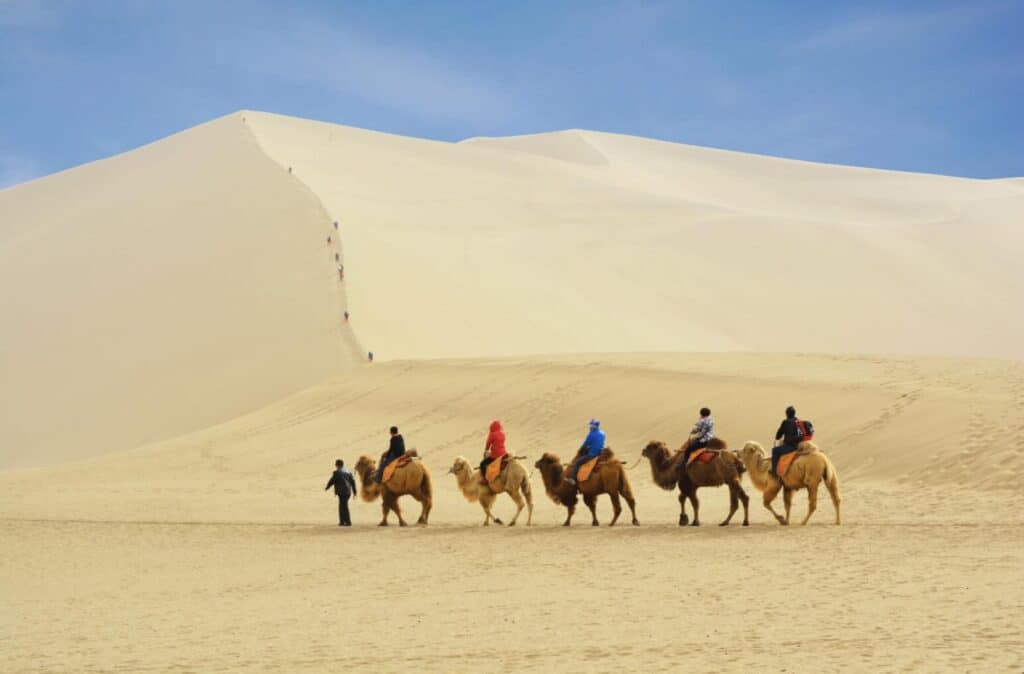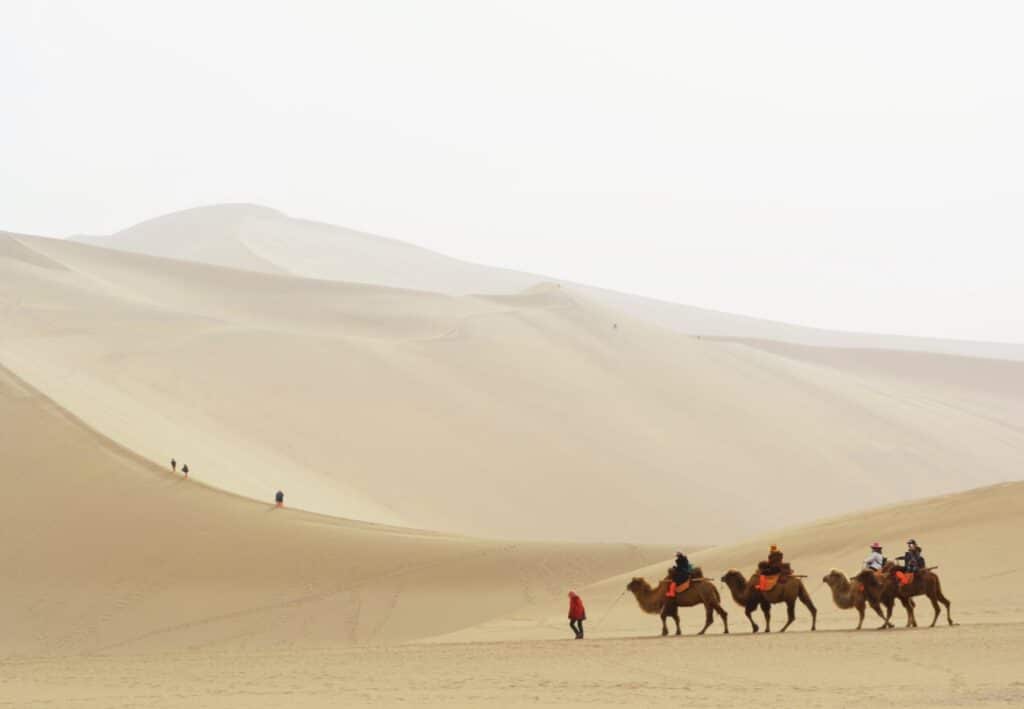The Silk Road stands as one of the most significant achievements in human history, a sprawling network of trade routes that connected Asia with Europe, Africa, and the Middle East. For centuries, it has served as the lifeline of global commerce, cultural exchange, and innovation, profoundly influencing civilizations. More than just a highway for goods, the Silk Road served as a bridge between worlds, facilitating the exchange of ideas, religions, technologies, and even culinary traditions.
We’ll delve into the history of the Silk Road, examining how it profoundly influenced global trade and culture. We’ll examine its role as a vital link between Asia and the rest of the world, and how it transformed civilizations by connecting continents. Finally, we’ll answer 15 frequently asked questions about the Silk Road and its lasting impact.
Table of Contents
- The Origins of the Silk Road
- How the Silk Road Shaped Global Trade
- How the Silk Road Shaped Culture
- The Silk Road’s Impact on Innovation
- The Decline of the Silk Road
- The Silk Road’s Legacy
- 15 Frequently Asked Questions About the Silk Road
- Related Questions
The Origins of the Silk Road
The Silk Road wasn’t a single road but rather a vast network of interconnected trade routes spanning thousands of miles. It emerged during the Han Dynasty in China (206 BCE–220 CE) and reached its peak between the 7th and 10th centuries.

Why Was It Called the Silk Road?
The name comes from one of the most prized commodities traded along the route: silk. Chinese silk was highly sought after in Europe and the Middle East, symbolizing luxury, wealth, and sophistication.
Key Regions Connected by the Silk Road:
- China: The starting point, where goods like silk, porcelain, and paper originated.
- Central Asia: A crossroads for traders, including cities like Samarkand and Bukhara.
- The Middle East: A hub for spices, textiles, and glassware.
- Europe: The endpoint for many goods, including silk and spices.
How the Silk Road Shaped Global Trade
The Silk Road revolutionized global trade by connecting distant civilizations that had previously been isolated from one another. It wasn’t just about the exchange of goods—it was about the creation of economic systems that spanned continents.
Key Contributions to Global Trade:
- Expansion of Markets:
The Silk Road enabled merchants to reach markets far beyond their local regions, thereby creating a truly global economy. - Introduction of New Goods:
Goods such as Chinese silk, Indian spices, Persian carpets, and European glass were traded, introducing new products to previously unexplored regions and creating demand for exotic items. - Standardization of Trade Practices:
The Silk Road helped standardize weights, measures, and currencies, facilitating smoother trade and cultural exchange between regions. - Development of Banking Systems:
Traders developed early forms of credit and banking to support long-distance commerce, laying the groundwork for modern financial systems.
How the Silk Road Shaped Culture
The Silk Road wasn’t just a trade route—it was a cultural superhighway, facilitating the exchange of ideas, beliefs, and traditions.
1. Spread of Religion:
Religions like Buddhism, Islam, Christianity, and Zoroastrianism traveled along the Silk Road, profoundly influencing societies across Asia, Europe, and the Middle East.
- Buddhism: Spread from India to China, Korea, and Japan, shaping art, architecture, and philosophy.
- Islam: Expanded through Central Asia, influencing governance, education, and cultural practices.
- Christianity: Found new followers in regions like Armenia and Georgia.
2. Exchange of Art and Literature:
Artistic styles and literary traditions were shared across cultures, leading to the fusion of ideas and the creation of new forms of expression.
- Persian Miniature Painting: Influenced by Chinese techniques.
- Chinese Poetry: Inspired by themes from Central Asia and the Middle East.
3. Culinary Exchange:
Food was one of the most tangible forms of cultural exchange along the Silk Road. Spices, cooking techniques, and ingredients traveled across continents, shaping cuisines in profound ways.
- Noodles: Likely originated in China and influenced Italian pasta.
- Spices: Indian and Middle Eastern spices transformed European cooking.
- Tea: Became a staple in cultures from China to the Middle East.
4. Language and Communication:
The Silk Road fostered the development of lingua franca languages—common tongues used for trade and diplomacy. For example:
- Sogdian: Used by Central Asian merchants.
- Arabic: Became a dominant language for trade in the Middle East.

The Silk Road’s Impact on Innovation
The Silk Road wasn’t just a route for goods—it was a conduit for knowledge and technology.
Key Innovations Spread Along the Silk Road:
- Paper:
Invented in China, paper traveled to the Middle East and Europe, revolutionizing communication and record-keeping. - Gunpowder:
Another Chinese invention, gunpowder, transformed warfare in Europe and the Middle East. - Mathematics:
Concepts such as algebra and the decimal system originated in India and the Middle East, and later traveled to Europe. - Medicine:
Medical knowledge, including herbal remedies and surgical techniques, was shared across cultures.
The Decline of the Silk Road
The Silk Road began to decline in the 15th century due to several factors:
- The Rise of Maritime Trade: Sea routes became more efficient for long-distance trade.
- The Fall of Empires: The collapse of the Mongol and other empires disrupted the stability of the Silk Road.
- Technological Advancements: Innovations like the compass and larger ships made oceanic trade more appealing.
The Silk Road’s Legacy
Despite its decline, the Silk Road’s impact is still felt today. It laid the foundation for globalization, connecting people and cultures in ways that continue to shape the modern world.
Modern Examples of Silk Road Influence:
- China’s Belt and Road Initiative: A modern attempt to recreate the Silk Road’s connectivity through infrastructure projects.
- Cultural Festivals: Celebrations of Silk Road heritage in cities like Samarkand and Xi’an.
- Global Cuisine: The fusion of flavors and techniques that originated along the Silk Road.
15 Frequently Asked Questions About the Silk Road
What was the Silk Road?
The Silk Road was a network of trade routes connecting Asia, Europe, Africa, and the Middle East, facilitating the exchange of goods, culture, and ideas.
Why was the Silk Road important?
It revolutionized global trade, fostered cultural exchange, and disseminated innovations such as paper, gunpowder, and mathematics.
What goods were traded on the Silk Road?
Silk, spices, porcelain, glassware, carpets, tea, and precious metals were among the most commonly traded goods.
How did the Silk Road shape culture?
It facilitated the exchange of religions, art, literature, food, and language, profoundly influencing societies across continents.
What religions spread along the Silk Road?
Buddhism, Islam, Christianity, and Zoroastrianism were among the religions that traveled along the Silk Road.
How did the Silk Road influence food?
Spices, cooking techniques, and ingredients such as noodles and tea have traveled across regions, shaping global cuisines.
What innovations spread along the Silk Road?
Paper, gunpowder, algebra, and medical knowledge were some of the key innovations shared along the Silk Road.
Who were the leading traders on the Silk Road?
Chinese, Indian, Persian, Arab, and Central Asian merchants were the primary traders on the Silk Road.
How did the Silk Road affect language?
It fostered the development of lingua franca languages, such as Sogdian and Arabic, facilitating communication between diverse cultures.
Why did the Silk Road decline?
The rise of maritime trade, the fall of empires, and technological advancements contributed to its decline.
What role did the Mongols play in the Silk Road?
The Mongols unified large portions of the Silk Road, creating stability and fostering trade during their reign.
How did the Silk Road influence Europe?
It introduced goods like silk and spices, as well as innovations like paper and gunpowder, transforming European societies.
What was the cultural significance of the Silk Road?
It created a global exchange of ideas, beliefs, and traditions, fostering mutual understanding between civilizations.
Is the Silk Road still relevant today?
Yes, its legacy continues through modern initiatives like China’s Belt and Road Initiative and the global fusion of cultures and cuisines.
How can I learn more about the Silk Road?
Visit historical sites like Xi’an and Samarkand, read books about Silk Road history, and explore museums dedicated to its heritage.
The Silk Road was far more than a trade route—it was a transformative force that shaped global trade, culture, and innovation. By connecting continents and civilizations, it fostered an exchange of goods, ideas, and traditions that continue to influence the modern world.

Understanding the Silk Road’s legacy enables us to appreciate the interconnectedness of human history and the significance of cultural exchange. Whether through trade, religion, or cuisine, the Silk Road reminds us that collaboration and curiosity are the keys to progress.
At A Bus On A Dusty Road, we discuss history, travel, life, sailing, and ex-pat living. We are all about “Living Life As A Global Citizen.” We explore social, cultural, and economic issues and travel.
We would love to have you be part of our community. Sign up for our newsletter to keep up-to-date by clicking here. If you have any questions, you can contact me, Anita, by clicking here.
Listen to our Podcast called Dusty Roads. You can find it on all major podcast platforms. Try out listening to one of our podcasts by clicking here.
Subscribe to our A Bus On A Dusty Road YouTube Channel filled with great videos and information.
Related Questions
What Makes Vietnamese Food So Delicious?
Vietnamese food is delicious and is gaining in popularity—one of the reasons is that good Vietnamese food uses only fresh herbs and ingredients. Vietnamese food also touches all of our five senses. The Vietnamese are masters at using sweet and sour tastes for their food.
You can discover more by reading What Makes Vietnamese Food So Delicious? by clicking here.
The Vietnamese Bun Cha Food Dish, All You Need To Know
One of North Vietnam’s most popular food dishes is bun cha. When you travel in North Vietnam, you will see signs everywhere advertising the sale of this famous dish called Bún Chả.
You can learn more by reading The Vietnamese Bun Cha Food Dish, All You Need To Know by clicking here.
Vietnamese Culture: Deep Dive Into Vietnam’s Culture
There’s so much we can learn from Vietnamese traditions and values. With its breathtaking landscapes, varied ecosystems, and vibrant cities, Vietnam is not merely a spot on a traveler’s itinerary. It’s a country rich in enduring traditions, values, and customs, offering a fascinating glimpse into Asia’s vast mosaic of cultures. Let’s delve deeper into why the Vietnamese culture is so captivating and rewarding to be immersed in.
By clicking here, you can discover Vietnamese Culture: Deep Dive Into Vietnam’s Culture.

